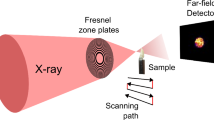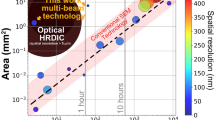Abstract
Background
X-ray imaging offers unique possibilities for Digital Image Correlation (DIC), opening the door for full-field deformation measurements of a test article in complex environments where optical DIC suffers severe biases or is impossible. While X-ray DIC has been performed in the past with standard DIC codes designed for optical images, the path-integrated nature of X-ray images places constraints on the experimental setup, predominantly that only a single surface of interest moves/deforms. These requirements are difficult to realize for many practical situations and limit the amount of information that can be garnered in a single test. Other X-ray based diagnostics such as Digital Volume Correlation (DVC) and Projection DVC (P-DVC) overcome these obstacles, but DVC is limited to quasi-static tests, and both DVC and P-DVC necessitate high-resolution computed tomography (CT) scan(s) and often require a potentially invasive pattern throughout the volume of the specimen.
Objective
This work presents a novel approach to measure time-resolved displacements and strains on multiple surfaces from a single series of 2D, path-integrated (PI) X-ray images, called PI-DIC.
Methods
The principle of optical flow or conservation of intensity—the foundation of DIC—was reframed for path-integrated images, for an exemplar setup comprised of two plates moving and deforming independently. Synthetic images were generated for rigid translations, rigid rotations, and uniform stretches, where each plate underwent a unique motion/deformation. Experimental specimens were fabricated (either an aluminum plate with tantalum features or a plastic plate with steel features) and the two specimens were independently translated.
Results
PI-DIC was successfully demonstrated with the synthetic images and validated with the experimental images. Prescribed displacements were recovered for each plate from the single set of path-integrated, deformed images. Errors were approximately 0.02 px for the synthetic images with 1.5% image noise, and 0.05 px for the experimental images.
Conclusions
These results provide the foundation for PI-DIC to measure motion and deformation of multiple, independent surfaces with subpixel accuracy from a single series of path-integrated X-ray images.
















Similar content being viewed by others
Notes
See MATLAB’s documentation for details of these optimizer options at https://www.mathworks.com/help/optim/ug/fminunc.html and https://www.mathworks.com/help/optim/ug/optimization-options-reference.html, accesseed 19 December 2022.
See https://www.mathworks.com/help/images/image-coordinate-systems.html for more information on image coordinates used in MATLAB.
References
Murphy AW, Zepper ET, Jones EMC, Quintana EC, Montoya MM, Cruz-Cabrera AA, Scott SN, Houchens BC (2021) Response of aluminum-skinned carbon-fiber-epoxy to heating by an adjacent fire. 12th U.S. National Combustion Meeting, Organized by the Central States Section of the Combustion Institute, College Station, TX
Jones EMC, Reu PL (2018) Distortion of digital image correlation (DIC) displacements and strains from heat waves. Exp Mech 58:1133–1159
Lynch KP, Jones EMC, Wagner JL (2020) High-precision digital image correlation for investigation of fluid-structure interactions in a shock tube. Exp Mech 60(8):1119–1133. https://doi.org/10.1007/s11340-020-00610-8
Smith CM, Hoehler MS (2018) Imaging through fire using narrow-spectrum illumination. Fire Technol 54:1705–1723
Abotula S, Heeder N, Chona R, Shukla A (2014) Dynamic thermo-mechanical response of Hastelloy X to shock wave loading. Exp Mech 54:279–291
Pan B, Wu D, Wang Z, Xia Y (2011) High-temperature digital image correlation method for full-field deformation measurement at 1200C. Meas Sci Technol 22:1–11
Gupta S, Parameswaran V, Sutton MA, Shukla A (2014) Study of dynamic underwater implosion mechanics using digital image correlation. Proc R Soc A 470:1–17
Reu PL, Miller TJ (2008) The application of high-speed digital image correlation. J Strain Anal 43:673–688
Pankow M, Justusson B, Waas AM (2010) Three-dimensional digital image correlation technique using single high-speed camera for measureming large out-of-plane displacements at high framing rates. Appl Optics 49(17):3418–3427
Giovannetti LM, Banks J, Turnock SR, Boyd SW (2017) Uncertainty assessment of coupled digital image correlation and particle image velocimetry for fluid-structure interaction wind tunnel experiments. J Fluid Struct 68:125–140
Spottswood SM, Beberniss TJ, Eason TG, Perez RA, Donbar JM, Ehrhardt DA, Riley ZB (2018) Exploring the response of a thin, flexible panel to shock-turbulent boundary-layer interactions. J Sound Vib. https://doi.org/10.1016/j.jsv.2018.11.035
Su Z, Pan J, Zhang S, Wu S, Yu Q, Zhang D (2022) Characterizing dynamic deformation of marine propeller blades with stroboscopic stereo digital image correlation. Mech Syst Signal Pr 162
Su Z, Pan J, Lu L, Dai M, He X, Zhang D (2021) Refractive three-dimensional reconstruction for underwater stereo digital image correlation. Opt Express 29(8):12131–12144. https://doi.org/10.1364/OE.421708
Ellis CL, Hazell P (2020) Visual methods to assess strain fields in armour materials subjected to dynamic deformation-a review. Appl Sci 10(8)
Russell SS, Sutton MA (1989) Strain-field analysis acquired through correlation of X-ray radiographs of a fiber-reinforced composite laminate. Exp Mech 29(2):237–240
Synnergren P, Goldrein HT, Proud WG (1999) Application of digital speckle photography to flash x-ray studies of internal deformation fields in impact experiments. Appl Optics 38(19):4030–4036
Prentice HJ, Proud WG, Walley SM, Field JE (2010) The use of digital speckle radiography to study the ballistic deformation of a polymer bounded sugar (an explosive simulant). Int J Impact Eng 37:1113–1120
Grantham SG, Goldrein HT, Proud WG, Field JE (2003) Digital speckle radiography-a new ballistic measurement technique. Imaging Sci J 51(3):175–186
Rae PJ, Williamson DM, Addiss J (2011) A comparison of 3 digital image correlation techniques on necessarily suboptimal random patterns recorded by x-ray. Exp Mech 51(4):467–477
Louis L, Wong T-F, Baud P (2007) Imaging strain localization by X-ray radiography and digital image correlation: deformation bands in Rothbach sandstone. J Struct Geol 29:129–140
Bay BK (1995) Texture correlation: a method for the measurement of detailed strain distributions within trabecular bone. J Orthop Res 13:258–267
Synnergren P, Goldrein HT (1999) Dynamic measurements of internal three-dimensional displacement fields with digital speckle photography and flash x-rays. Appl Optics 38(28):5956–5961
Jones EMC, Quintana EC, Reu PL, Wagner JL (2019) X-ray stereo digital image correlation. Exp Tech 44(2):159–174
James JW, Jones EMC, Quintana EC, Lynch KP, Halls BR, Wagner JL (2021) High-speed x-ray stereo digital image correlation in a shock tube. Exp Tech
Rohe DP, Quintana EC, Witt BL, Halls BR (2020) Structural dynamic measurements using high-speed x-ray digital image correlation. IMAC XXXIX, Virtual Conference
Bay BK (2008) Methods and applications of digital volume correlation. J Strain Anal 43:745–760
Saayman J, Nicol W, Van Ommen JR, Mudde RF (2013) Fast x-ray tomography for the quantification of the bubbling-, turbulent- and fast fluidization-flow regimes and void structures. Chem Eng J 234:437–447. https://doi.org/10.1016/j.cej.2013.09.008
Moser S, Nau S, Salk M, Thoma K (2014) In situ flash x-ray high-speed computed tomography for the quantitative analysis of highly dynamic processes. Meas Sci Technol 25(2). https://doi.org/10.1088/0957-0233/25/2/025009
Zellner MB, Perrella J, Schall D, Ducote A, Nellenbach T, O’Connor T, Quigg T, Sturgill N (2018) Assessing x-ray contamination from neighboring sources in the US Army Research Laboratory’s (ARL’s) multi-energy flash computed tomography diagnostic. ARL Technical Report, ARL-TR-8452
Halls BR, Rahman N, Slipchenko MN, James JW, McMaster A, Ligthfoot MDA, Gord JR, Meyer TR (2019) 4D spatiotemporal evolution of liquid spray using kilohertz-rate x-ray computed tomography. Opt Lett 44(20):5013–5016. https://doi.org/10.1364/OL.44.005013
Gupta A, Crum RS, Zhai C, Ramesh KT, Hurley RC (2021) Quantifying particle-scale 3D granular dynamics during rapid compaction from time-resolved in situ 2D x-ray images. J Appl Phys 129(22)
Taillandier-Thomas T, Roux S, Hild F (2016) Soft route to 4D tomography. Phys Rev Lett 117(2):025501. https://doi.org/10.1103/PhysRevLett.117.025501
Khalili MH, Brisard S, Bornert M, Aimedieu P, Pereira JM, Roux JN (2017) Discrete digital projections correlation: a reconstruction-free method to quantify local kinematics in granular media by x-ray tomography. Exp Mech 57(6):819–830
Leclerc H, Roux S, Hild F (2014) Projection savings in CT-based digital volume correlation. Exp Mech 55(1):275–287
Schreier H, Orteu J-J, Sutton MA (2009) Image correlation for shape, motion and deformation measurements. Springer, US
Shi Y, Blaysat B, Chanal H, Grédiac M (2023) Introducing virtual DIC to remove interpolation bias and process optimal patterns. Exp Mech. https://doi.org/10.1007/s11340-023-00941-2
Reu PL, Toussaint E, Jones E, Bruck HA, Iadicola M, Balcaen R, Turner DZ, Siebert T, Lava P, Simonsen M (2017) DIC challenge: Developing images and guidelines for evaluating accuracy and resolution of 2D analyses. Exp Mech 58(7):1067–1099. https://doi.org/10.1007/s11340-017-0349-0
Reu PL, Blaysat B, Ando E, Bhattacharya K, Couture C, Vouty V, Deb D, Fayad SS, Iadicola MA, Jaminion S, Klein M, Landauer AK, Lava P, Liu M, Luan LK, Olufsen SN, Réthoré J, Roubin E, Seidl DT, Siebert T, Stamati O, Toussaint E, Turner D, Vemulapati CSR, Weikert T, Witz JF, Witzel O, Yang J (2022) DIC challenge 2.0: developing images and guidelines for evaluating accuracy and resolution of 2D analyses, focus on the metrological efficiency indicator. Exp Mech 62:639–654. https://doi.org/10.1007/s11340-021-00806-6
Reu PL (2010) Experimental and numerical methods for exact subpixel shifting. Exp Mech 51(4):443–452. https://doi.org/10.1007/s11340-010-9417-4
Bornert M, Doumalin P, Dupré J-C, Poilâne C, Robert L, Toussaint E, Wattrisse B (2017) Shortcut in DIC error assessment induced by image interpolation used for subpixel shifting. Opt Laser Eng 91:124–133
Joint Committee for Guides in Metrology (JCGM) (2007) International vocabulary of basic and general terms in metrology (VIM). JCGM 200:2007(E). https://www.iso.org/sites/JCGM/VIM-introduction.htm. Accessed 12 Dec 2022
Schreier HW, Braasch JR, Sutton MA (2000) Systematic errors in digital image correlation caused by intensity interpolation. Opt Eng 39(11):2915–2921
Lifton J, Liu T (2019) Ring artefact reduction via multi-point piecewise linear flat field correction for x-ray computed tomography. Opt Express 27(3):3217–3228. https://doi.org/10.1364/OE.27.003217
Acknowledgements
The authors thank Dr. D. Tom Seidl, Dr. Phillip Reu, and Dr. Daniel Turner for helpful discussion and feedback in the initial stages of development of PI-DIC; Andrew Lentfer and Dayna Obenauf for assistance collecting the experimental data; Kyle Thompson and Ryan Goodner for help regarding radiograph image processing; and Dr. Dan Rohe, Dr. John Miers, and Dr. Linda Hansen for careful review and feedback of the manuscript.
Funding
This article has been authored by an employee of National Technology and Engineering Solutions of Sandia, LLC under contract DE-NA0003525 with the U.S. Department of Energy (DOE). The employee owns all right, title and interest in and to the article and is solely responsible for its contents. The United States Government retains and the publisher, by accepting for publication, acknowledges that the United States Government retains a non-exclusive, paid-up, irrevocable, world-wide license to publish or reproduce the published form of this article or allow others to do so, for United States Government purposes. The DOE will provide public access to these results of federally sponsored research in accordance with the DOE Public Access Plan, https://www.energy.gov/downloads/doe-public-access-plan. This paper describes objective technical results and analysis. Any subjective views or opinions that might be expressed in the paper do not necessarily represent the views of the U.S. Department of Energy or the United States Government.
Author information
Authors and Affiliations
Contributions
Author contributions are recognized using the Contributor Roles Taxonomy (CRediT), https://doi.org/10.1002/leap.1210. Elizabeth M. C. Jones: Conceptualization; Data curation; Formal analysis; Investigation; Methodology; Software; Visualization; Writing—Original draft; Writing—Review & editing. Samuel S. Fayad: Investigation; Methodology; Visualization; Writing—Original draft; Writing—Review & editing. Enrico C. Quintana: Resources; Writing—Review & editing. Benjamin R. Halls: Writing—Review & editing. Caroline Winters: Funding acquisition; Project administration; Writing—Review & editing
Corresponding author
Ethics declarations
Conflict of Interest
The authors declare they have no conflict of interest.
Additional information
Publisher’s Note
Springer Nature remains neutral with regard to jurisdictional claims in published maps and institutional affiliations.
Supplementary Information
Below is the link to the electronic supplementary material.
Rights and permissions
Springer Nature or its licensor (e.g. a society or other partner) holds exclusive rights to this article under a publishing agreement with the author(s) or other rightsholder(s); author self-archiving of the accepted manuscript version of this article is solely governed by the terms of such publishing agreement and applicable law.
About this article
Cite this article
Jones, E., Fayad, S., Quintana, E. et al. Path-Integrated X-Ray Images for Multi-Surface Digital Image Correlation (PI-DIC). Exp Mech 63, 681–701 (2023). https://doi.org/10.1007/s11340-023-00949-8
Received:
Accepted:
Published:
Issue Date:
DOI: https://doi.org/10.1007/s11340-023-00949-8




